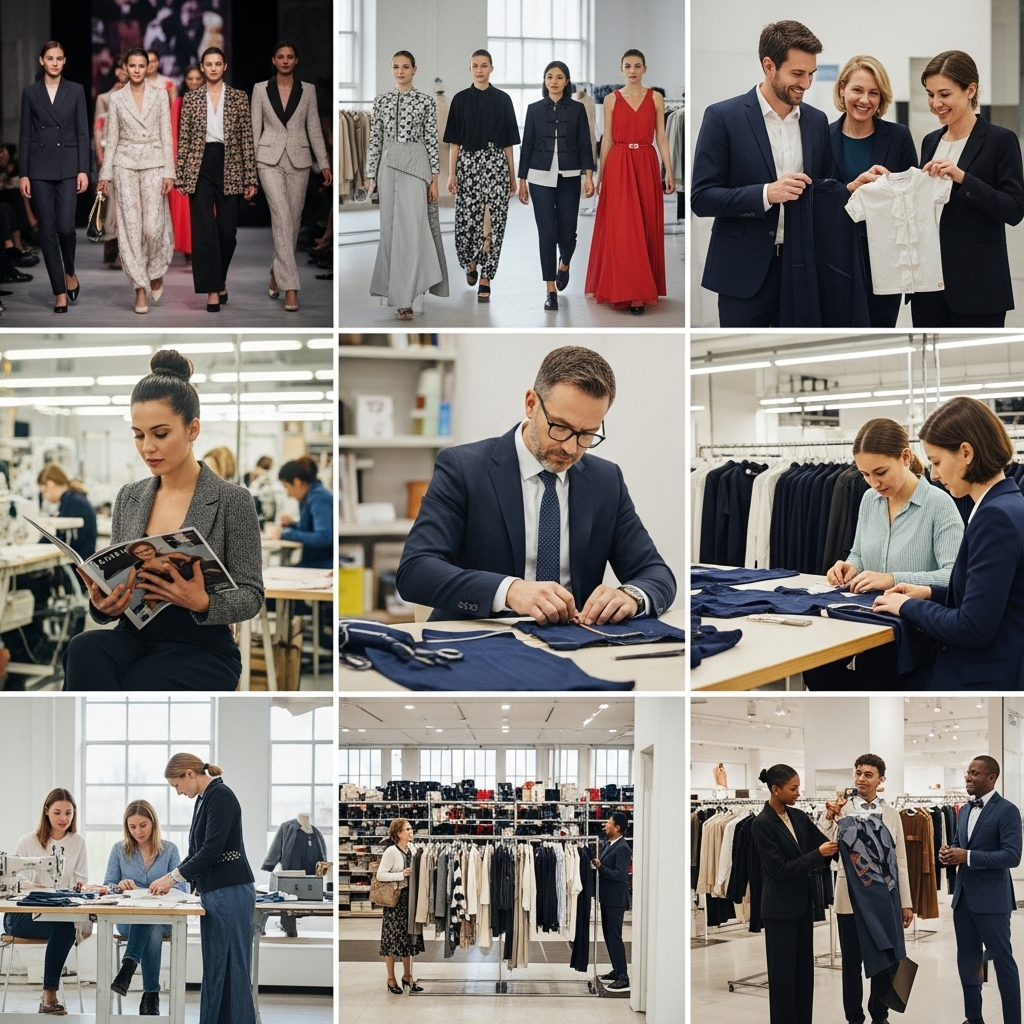Blog
The Business of Fashion: From Runway to Retail

Beyond the glamour of the catwalk and the allure of celebrity endorsements, the fashion industry is a colossal global business, a complex ecosystem driven by creativity, commerce, and intricate supply chains. It’s a multi-trillion-dollar industry, employing millions worldwide, and its journey from a designer’s initial sketch to a garment hanging in a retail store is a meticulously orchestrated process. Understanding the business of fashion means delving into the interconnected stages of design, manufacturing, marketing, and sales, recognizing the vast network of professionals and processes that bring trends to life and products to consumers.
Design and Concept: The Genesis of Style
Every collection begins with an idea, a vision that often stems from a creative director or a design team. This initial phase is steeped in trend forecasting, where fashion houses analyze societal shifts, economic indicators, art, music, and emerging cultural movements to predict future aesthetics. Designers then translate these insights into mood boards, a collage of images, colors, textures, and themes that capture the essence of the upcoming collection.
The creative process then moves to sketching and pattern making. Designers draw initial garment concepts, which are then translated into precise patterns, the blueprints for the physical clothes. Fabric sourcing is crucial at this stage; designers meticulously select textiles, trims, and embellishments that align with their vision and the collection’s narrative. This involves working closely with textile mills and suppliers, considering not only aesthetics but also functionality, cost, and increasingly, sustainability. The role of the creative director is paramount here, guiding the overall aesthetic and ensuring brand consistency across all lines.
Manufacturing and Production: The Global Assembly Line
Once designs are finalized, they enter the manufacturing phase, a complex global operation. Prototyping and sampling are critical first steps, where initial versions of garments are created, fitted, and refined to perfect the design and ensure manufacturability. This stage often involves several iterations, with adjustments made to patterns and construction methods.
Production typically takes place in factories, often located in countries with lower labor costs, such as China, Bangladesh, Vietnam, and Turkey. This globalized supply chain involves numerous stages: fabric cutting, sewing, finishing, quality control, and packaging. Outsourcing is common, with fashion brands contracting third-party manufacturers. This strategy allows brands to leverage specialized expertise and cost efficiencies but also presents challenges in terms of ethical oversight and quality control. Ensuring fair labor practices and safe working conditions in these factories is a growing concern and a significant challenge for the industry. Logistics play a massive role here, with garments needing to be transported efficiently across continents, adding to the complexity and carbon footprint of the industry.
Wholesale vs. Retail: Reaching the Consumer
After production, garments embark on their journey to the consumer, primarily through wholesale or direct retail channels.
Wholesale: Traditionally, fashion brands would sell their collections to retailers (department stores, boutiques, multi-brand online stores) at a wholesale price. These retailers then mark up the products and sell them to end-consumers. This model allows brands to reach a wider audience without managing their own extensive retail operations.
Retail (Direct-to-Consumer – D2C): Increasingly, brands are opting for a direct-to-consumer (D2C) model, selling directly to customers through their own brick-and-mortar stores, e-commerce websites, or pop-up shops. This allows brands to have greater control over their brand image, customer experience, and pricing, while also capturing a larger share of the profit margin. The rise of e-commerce has significantly accelerated the D2C trend.
Marketing and Branding: Crafting Desire
In the highly competitive fashion landscape, effective marketing and branding are crucial for creating desire, building loyalty, and distinguishing one brand from another.
Fashion Shows: These elaborate spectacles, held in fashion capitals like Paris, Milan, New York, and London, are not just about presenting new collections. They are powerful marketing tools, generating buzz, setting trends, and creating aspirational imagery. They serve as a launchpad for media coverage and dictate the visual narrative for the upcoming season.
Advertising: From glossy print campaigns in magazines to sophisticated digital ads, social media campaigns, and billboard displays, advertising shapes consumer perception.
Celebrity Endorsements and Influencer Marketing: Aligning brands with celebrities or social media influencers has become a dominant marketing strategy. These partnerships leverage the star power and reach of personalities to connect with target audiences.
Brand Identity: This encompasses everything from a brand’s logo, color palette, and store design to its communication style and core values. A strong brand identity creates an emotional connection with consumers and fosters brand recognition and loyalty. Storytelling around the brand’s heritage, craftsmanship, or mission is often central to this.
Retail Operations: The Final Frontier
The retail environment is where the customer interaction truly happens. Whether online or in a physical store, the goal is to provide a seamless and compelling shopping experience.
Brick-and-Mortar Stores: These involve careful consideration of store layout, visual merchandising (how products are displayed to entice customers), customer service, and inventory management. The physical store environment is crucial for brand immersion and allows customers to touch, feel, and try on garments.
E-commerce Platforms: Online retail requires robust website design, intuitive navigation, high-quality product photography, efficient payment gateways, and seamless fulfillment and shipping processes. Returns management is also a critical part of the online retail experience.
Customer Experience: Regardless of the channel, providing excellent customer service, personalized recommendations, and a positive shopping journey is paramount for repeat business and brand advocacy.
Inventory Management: Balancing supply and demand to minimize overstocking (which leads to discounts and waste) and understocking (which leads to missed sales) is a perpetual challenge in fashion retail.
The Role of Technology: Driving Efficiency and Innovation
Technology is increasingly interwoven into every aspect of the fashion business, transforming operations and consumer interactions:
AI (Artificial Intelligence) and Big Data: Used for sophisticated trend forecasting, predicting consumer demand with greater accuracy, optimizing pricing strategies, and personalizing marketing messages. AI-powered tools can analyze vast amounts of data from social media, sales figures, and fashion shows to identify emerging patterns.
Virtual Try-on and Augmented Reality (AR): Enhancing the online shopping experience by allowing customers to virtually try on clothes using their smartphones or computers, reducing returns.
E-commerce Platforms: Sophisticated platforms provide brands with the tools to manage online stores, process orders, and analyze sales data.
Supply Chain Management Software: Improving efficiency, traceability, and transparency throughout the production and logistics process.
3D Design Software: Allowing designers to create virtual prototypes, reducing the need for physical samples, saving time and materials.
Challenges in the Industry: Navigating a Dynamic Landscape
Despite its glamour, the fashion business faces significant challenges:
Fast Fashion Demands: The relentless pressure to produce new collections quickly and cheaply puts immense strain on supply chains and often compromises ethical practices.
Rising Production Costs: Fluctuations in material prices, labor costs, and shipping can impact profitability.
Intellectual Property Theft: Design copying and counterfeiting remain persistent issues, particularly for luxury brands.
Economic Downturns: Fashion is a discretionary purchase, making the industry vulnerable to economic fluctuations and changes in consumer spending habits.
Sustainability Pressure: Brands are under increasing pressure from consumers, investors, and regulators to adopt more sustainable and ethical practices, requiring significant investments and operational changes.
Digital Disruption: The rapid evolution of e-commerce, social media, and new technologies constantly reshapes consumer expectations and competitive landscapes.
Future Trends in Fashion Business: Adapt or Perish
The future of the fashion business will likely be characterized by:
Increased Personalization: From custom-made garments based on body scans to highly curated product recommendations.
On-Demand Manufacturing: Reducing waste and lead times by producing garments only when an order is placed.
Direct-to-Consumer Dominance: More brands bypassing traditional retail to build direct relationships with customers.
Enhanced Transparency: Consumers will demand greater visibility into how and where their clothes are made.
Circular Business Models: Rental, resale, repair, and recycling becoming mainstream revenue streams for brands.
Phygital Experiences: Blending physical and digital retail to offer immersive and interactive shopping journeys.
Conclusion: A Blend of Art and Enterprise
The business of fashion is a vibrant and ever-evolving landscape, a testament to the intricate balance between artistic vision and commercial acumen. It’s an industry that thrives on creativity, yet is underpinned by rigorous logistical planning, financial management, and strategic marketing. From the initial spark of an idea on a designer’s mood board to the garment’s final destination in a customer’s wardrobe, every step is a calculated move in a complex global game. As the industry continues to grapple with challenges like sustainability and digital transformation, its ability to adapt and innovate will determine its trajectory into a new era of style and commerce.
